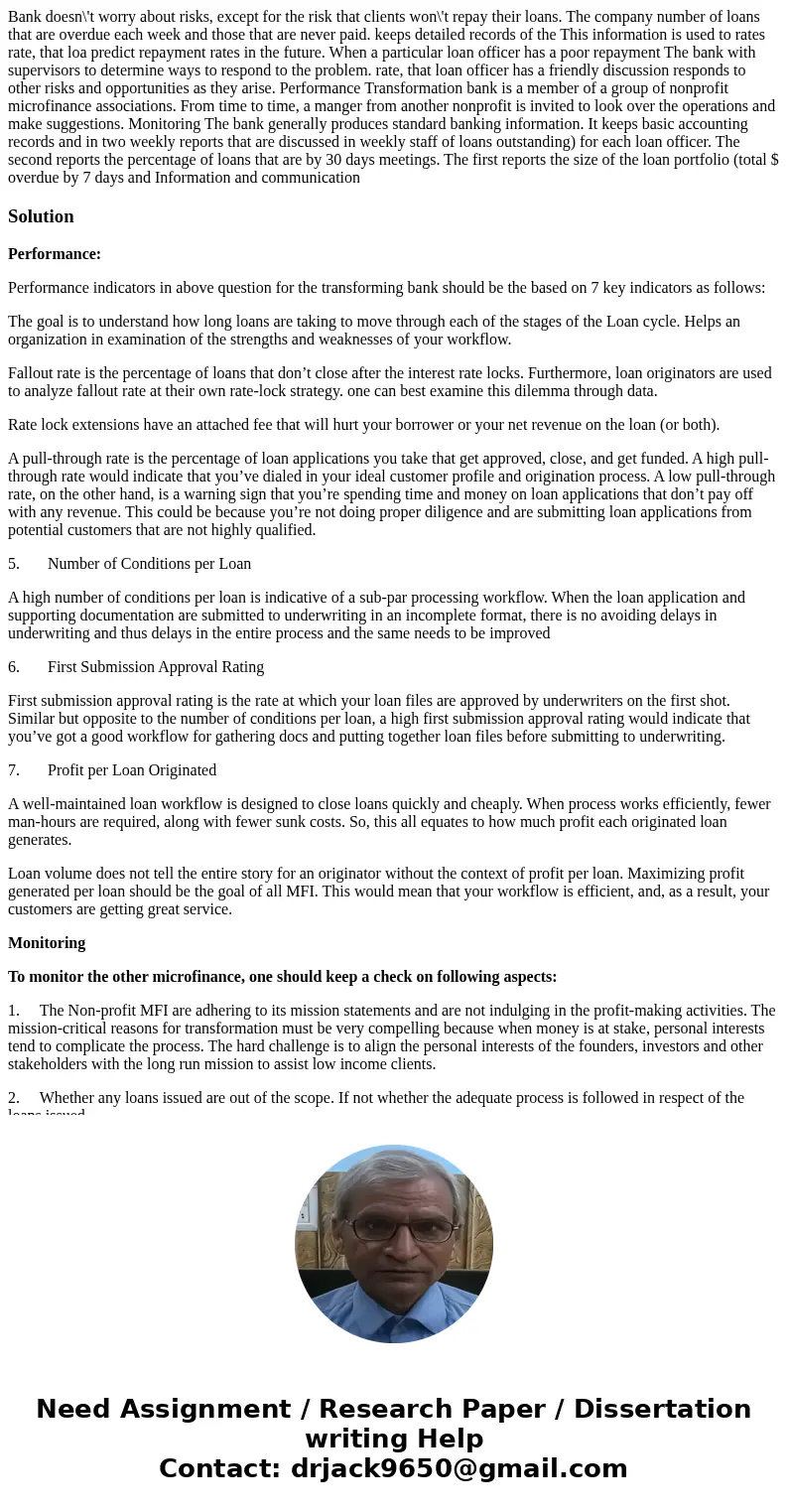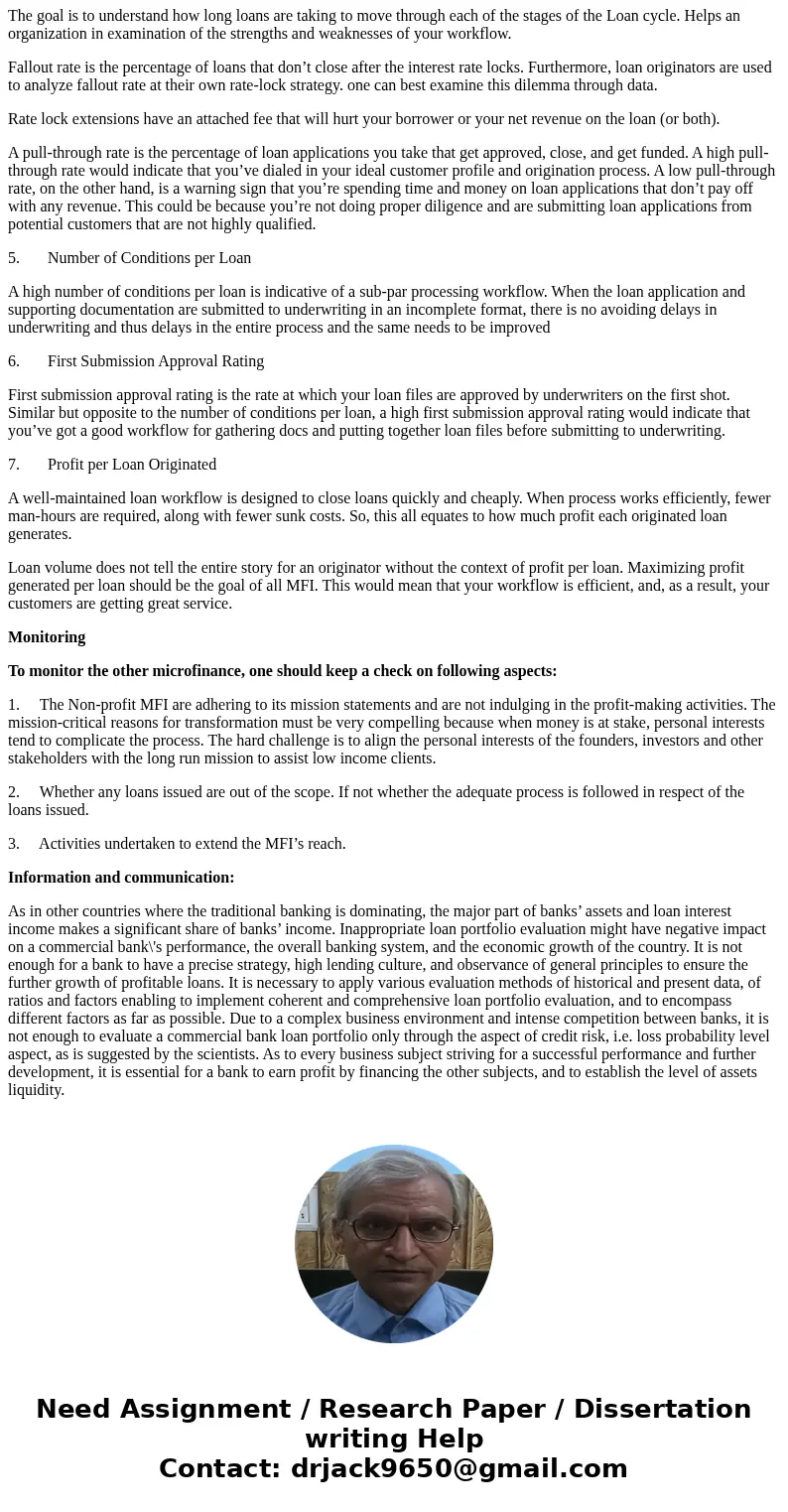Bank doesnt worry about risks except for the risk that clien
Solution
Performance:
Performance indicators in above question for the transforming bank should be the based on 7 key indicators as follows:
The goal is to understand how long loans are taking to move through each of the stages of the Loan cycle. Helps an organization in examination of the strengths and weaknesses of your workflow.
Fallout rate is the percentage of loans that don’t close after the interest rate locks. Furthermore, loan originators are used to analyze fallout rate at their own rate-lock strategy. one can best examine this dilemma through data.
Rate lock extensions have an attached fee that will hurt your borrower or your net revenue on the loan (or both).
A pull-through rate is the percentage of loan applications you take that get approved, close, and get funded. A high pull-through rate would indicate that you’ve dialed in your ideal customer profile and origination process. A low pull-through rate, on the other hand, is a warning sign that you’re spending time and money on loan applications that don’t pay off with any revenue. This could be because you’re not doing proper diligence and are submitting loan applications from potential customers that are not highly qualified.
5. Number of Conditions per Loan
A high number of conditions per loan is indicative of a sub-par processing workflow. When the loan application and supporting documentation are submitted to underwriting in an incomplete format, there is no avoiding delays in underwriting and thus delays in the entire process and the same needs to be improved
6. First Submission Approval Rating
First submission approval rating is the rate at which your loan files are approved by underwriters on the first shot. Similar but opposite to the number of conditions per loan, a high first submission approval rating would indicate that you’ve got a good workflow for gathering docs and putting together loan files before submitting to underwriting.
7. Profit per Loan Originated
A well-maintained loan workflow is designed to close loans quickly and cheaply. When process works efficiently, fewer man-hours are required, along with fewer sunk costs. So, this all equates to how much profit each originated loan generates.
Loan volume does not tell the entire story for an originator without the context of profit per loan. Maximizing profit generated per loan should be the goal of all MFI. This would mean that your workflow is efficient, and, as a result, your customers are getting great service.
Monitoring
To monitor the other microfinance, one should keep a check on following aspects:
1. The Non-profit MFI are adhering to its mission statements and are not indulging in the profit-making activities. The mission-critical reasons for transformation must be very compelling because when money is at stake, personal interests tend to complicate the process. The hard challenge is to align the personal interests of the founders, investors and other stakeholders with the long run mission to assist low income clients.
2. Whether any loans issued are out of the scope. If not whether the adequate process is followed in respect of the loans issued.
3. Activities undertaken to extend the MFI’s reach.
Information and communication:
As in other countries where the traditional banking is dominating, the major part of banks’ assets and loan interest income makes a significant share of banks’ income. Inappropriate loan portfolio evaluation might have negative impact on a commercial bank\'s performance, the overall banking system, and the economic growth of the country. It is not enough for a bank to have a precise strategy, high lending culture, and observance of general principles to ensure the further growth of profitable loans. It is necessary to apply various evaluation methods of historical and present data, of ratios and factors enabling to implement coherent and comprehensive loan portfolio evaluation, and to encompass different factors as far as possible. Due to a complex business environment and intense competition between banks, it is not enough to evaluate a commercial bank loan portfolio only through the aspect of credit risk, i.e. loss probability level aspect, as is suggested by the scientists. As to every business subject striving for a successful performance and further development, it is essential for a bank to earn profit by financing the other subjects, and to establish the level of assets liquidity.


 Homework Sourse
Homework Sourse